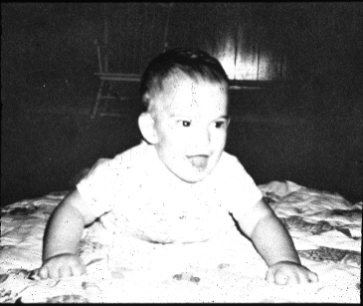|
Tay Sachs Disease: the incurable
For unlucky people who are born with this autosomal recessive disease, life is short. Tay Sachs Disease survivors total zero; every one dies. This disease, seen more often in Jewish people than in any other group, kills people within the first couple of years of their life. What is this disease? Tay Sachs is a recessive genetic mutation on chromosome 15 which prevents humans from making proteins needed to break down special lipids, called glycolipids. The glycolipids build up around the brain and after about a year of life, the child shows symptoms described further on in this page.
|
 Child with Tay Sachs before symptoms show up
Child with Tay Sachs before symptoms show up
Notice the action pose he is in, and the happiness on his face. He has not yet reached a point where the accumulation of the lipids in his brain have caused muscular dystrophy or mental retardation. |
|
Inheriting this disease
For a person to inherit Tay Sachs Disease, his/her parents must both have the recessive allele. The parents will be heterozygous and be missing some of the proteins needed to break down the lipds, but they will have enough to live a healthy life. Children with Tay Sachs will be homosygous recessive for the disease. They will not pass it onto their kids as they will not even live to be a grade school student.
|
|
Symptoms of Tay Sachs Disease
Children do not show symptoms of this disease during most of their first year of life. They slowly begin to lose musuclar control until they are completely parylized. Parents notice this degeneration as their kids stop trying to further their motor skills. As if it is not bad enough that these children lose their ability to move, they also go blind, and deaf. Eventually, they are put on machines and taken care of until they die.
Detection of Tay Sachs Disease
Around 6-8 months, parents can get their children's eyes tested. If the child has Tay Sachs Disease, a "cherry red spot" will show up in the eye. Unfortunately, there is no cure yet for Tay Sachs, as well as no treatment of any form. Doctors can now check the DNA and the enzymes in people to see if they have the recessive allele, but there is not much that can be done thus far to our medical knowledge. Scientists hope that eventually Tay Sachs will respond to a cure but that is only a hope. If the child has Tay Sachs, CAT scans can show if there is an accumulation of glycolipids in the region of the brain.
Add your link here
|
 The same child after symptoms have shown up
The same child after symptoms have shown up
This differences between this child in the first picture and in this picture are obvious. There is very little life in this child. Note his arms out in an unnatural position as if he can't move them back. Also, note his facial expression, or lack there of one. |


